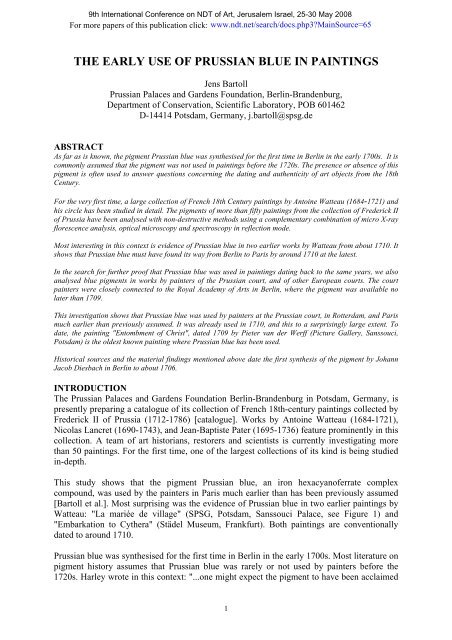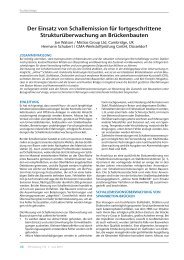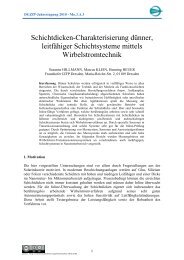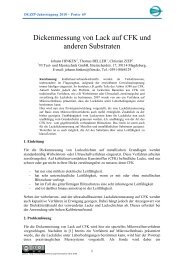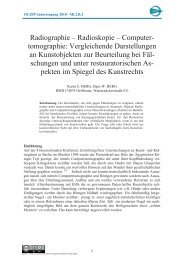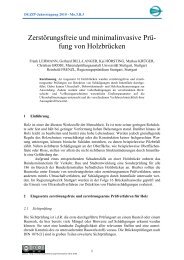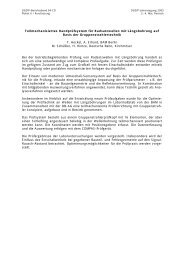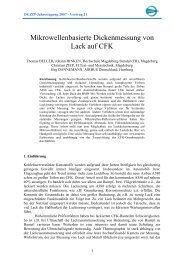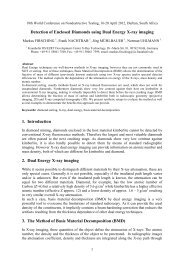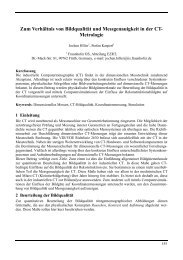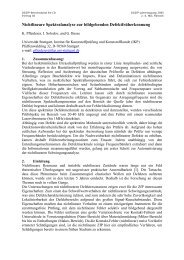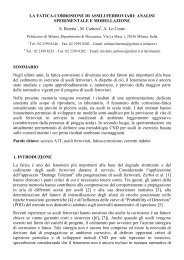The Early Use of Prussian Blue in Paintings - NDT.net
The Early Use of Prussian Blue in Paintings - NDT.net
The Early Use of Prussian Blue in Paintings - NDT.net
You also want an ePaper? Increase the reach of your titles
YUMPU automatically turns print PDFs into web optimized ePapers that Google loves.
9th International Conference on <strong>NDT</strong> <strong>of</strong> Art, Jerusalem Israel, 25-30 May 2008<br />
For more papers <strong>of</strong> this publication click: www.ndt.<strong>net</strong>/search/docs.php3?Ma<strong>in</strong>Source=65<br />
THE EARLY USE OF PRUSSIAN BLUE IN PAINTINGS<br />
Jens Bartoll<br />
<strong>Prussian</strong> Palaces and Gardens Foundation, Berl<strong>in</strong>-Brandenburg,<br />
Department <strong>of</strong> Conservation, Scientific Laboratory, POB 601462<br />
D-14414 Potsdam, Germany, j.bartoll@spsg.de<br />
ABSTRACT<br />
As far as is known, the pigment <strong>Prussian</strong> blue was synthesised for the first time <strong>in</strong> Berl<strong>in</strong> <strong>in</strong> the early 1700s. It is<br />
commonly assumed that the pigment was not used <strong>in</strong> pa<strong>in</strong>t<strong>in</strong>gs before the 1720s. <strong>The</strong> presence or absence <strong>of</strong> this<br />
pigment is <strong>of</strong>ten used to answer questions concern<strong>in</strong>g the dat<strong>in</strong>g and authenticity <strong>of</strong> art objects from the 18th<br />
Century.<br />
For the very first time, a large collection <strong>of</strong> French 18th Century pa<strong>in</strong>t<strong>in</strong>gs by Anto<strong>in</strong>e Watteau (1684-1721) and<br />
his circle has been studied <strong>in</strong> detail. <strong>The</strong> pigments <strong>of</strong> more than fifty pa<strong>in</strong>t<strong>in</strong>gs from the collection <strong>of</strong> Frederick II<br />
<strong>of</strong> Prussia have been analysed with non-destructive methods us<strong>in</strong>g a complementary comb<strong>in</strong>ation <strong>of</strong> micro X-ray<br />
florescence analysis, optical microscopy and spectroscopy <strong>in</strong> reflection mode.<br />
Most <strong>in</strong>terest<strong>in</strong>g <strong>in</strong> this context is evidence <strong>of</strong> <strong>Prussian</strong> blue <strong>in</strong> two earlier works by Watteau from about 1710. It<br />
shows that <strong>Prussian</strong> blue must have found its way from Berl<strong>in</strong> to Paris by around 1710 at the latest.<br />
In the search for further pro<strong>of</strong> that <strong>Prussian</strong> blue was used <strong>in</strong> pa<strong>in</strong>t<strong>in</strong>gs dat<strong>in</strong>g back to the same years, we also<br />
analysed blue pigments <strong>in</strong> works by pa<strong>in</strong>ters <strong>of</strong> the <strong>Prussian</strong> court, and <strong>of</strong> other European courts. <strong>The</strong> court<br />
pa<strong>in</strong>ters were closely connected to the Royal Academy <strong>of</strong> Arts <strong>in</strong> Berl<strong>in</strong>, where the pigment was available no<br />
later than 1709.<br />
This <strong>in</strong>vestigation shows that <strong>Prussian</strong> blue was used by pa<strong>in</strong>ters at the <strong>Prussian</strong> court, <strong>in</strong> Rotterdam, and Paris<br />
much earlier than previously assumed. It was already used <strong>in</strong> 1710, and this to a surpris<strong>in</strong>gly large extent. To<br />
date, the pa<strong>in</strong>t<strong>in</strong>g "Entombment <strong>of</strong> Christ", dated 1709 by Pieter van der Werff (Picture Gallery, Sanssouci,<br />
Potsdam) is the oldest known pa<strong>in</strong>t<strong>in</strong>g where <strong>Prussian</strong> blue has been used.<br />
Historical sources and the material f<strong>in</strong>d<strong>in</strong>gs mentioned above date the first synthesis <strong>of</strong> the pigment by Johann<br />
Jacob Diesbach <strong>in</strong> Berl<strong>in</strong> to about 1706.<br />
INTRODUCTION<br />
<strong>The</strong> <strong>Prussian</strong> Palaces and Gardens Foundation Berl<strong>in</strong>-Brandenburg <strong>in</strong> Potsdam, Germany, is<br />
presently prepar<strong>in</strong>g a catalogue <strong>of</strong> its collection <strong>of</strong> French 18th-century pa<strong>in</strong>t<strong>in</strong>gs collected by<br />
Frederick II <strong>of</strong> Prussia (1712-1786) [catalogue]. Works by Anto<strong>in</strong>e Watteau (1684-1721),<br />
Nicolas Lancret (1690-1743), and Jean-Baptiste Pater (1695-1736) feature prom<strong>in</strong>ently <strong>in</strong> this<br />
collection. A team <strong>of</strong> art historians, restorers and scientists is currently <strong>in</strong>vestigat<strong>in</strong>g more<br />
than 50 pa<strong>in</strong>t<strong>in</strong>gs. For the first time, one <strong>of</strong> the largest collections <strong>of</strong> its k<strong>in</strong>d is be<strong>in</strong>g studied<br />
<strong>in</strong>-depth.<br />
This study shows that the pigment <strong>Prussian</strong> blue, an iron hexacyan<strong>of</strong>errate complex<br />
compound, was used by the pa<strong>in</strong>ters <strong>in</strong> Paris much earlier than has been previously assumed<br />
[Bartoll et al.]. Most surpris<strong>in</strong>g was the evidence <strong>of</strong> <strong>Prussian</strong> blue <strong>in</strong> two earlier pa<strong>in</strong>t<strong>in</strong>gs by<br />
Watteau: "La mariée de village" (SPSG, Potsdam, Sanssouci Palace, see Figure 1) and<br />
"Embarkation to Cythera" (Städel Museum, Frankfurt). Both pa<strong>in</strong>t<strong>in</strong>gs are conventionally<br />
dated to around 1710.<br />
<strong>Prussian</strong> blue was synthesised for the first time <strong>in</strong> Berl<strong>in</strong> <strong>in</strong> the early 1700s. Most literature on<br />
pigment history assumes that <strong>Prussian</strong> blue was rarely or not used by pa<strong>in</strong>ters before the<br />
1720s. Harley wrote <strong>in</strong> this context: "...one might expect the pigment to have been acclaimed<br />
1
immediately by artists, but such was not the case." and "...it appears to have been well<br />
established by the middle <strong>of</strong> the eighteenth century..." [Harley]. Assum<strong>in</strong>g the stylistic dat<strong>in</strong>g<br />
<strong>of</strong> the pa<strong>in</strong>t<strong>in</strong>gs is correct, this means that <strong>Prussian</strong> blue must have found its way from Berl<strong>in</strong><br />
to Paris by around 1710 at the latest.<br />
Figure 1: A. Watteau, "La mariée de village" (SPSG, Sanssouci Palace, Inv. No. GK I 5603, photo: W. Pfauder)<br />
Watteau pa<strong>in</strong>ted the sky and figures with ultramar<strong>in</strong>, and an underlayer conta<strong>in</strong><strong>in</strong>g <strong>Prussian</strong> blue.<br />
<strong>The</strong> question <strong>of</strong> the early use <strong>of</strong> <strong>Prussian</strong> blue is <strong>of</strong> some importance, because the presence or<br />
absence <strong>of</strong> the pigment <strong>in</strong> art objects is frequently used for their relative dat<strong>in</strong>g, and to answer<br />
questions concern<strong>in</strong>g authenticity. This work aims to clarify some misunderstand<strong>in</strong>gs<br />
concern<strong>in</strong>g the first production and use <strong>of</strong> <strong>Prussian</strong> blue <strong>in</strong> pa<strong>in</strong>t<strong>in</strong>gs. In order to do this,<br />
historical sources were studied and a number <strong>of</strong> pa<strong>in</strong>t<strong>in</strong>gs were analysed <strong>in</strong> search <strong>of</strong> new<br />
material f<strong>in</strong>d<strong>in</strong>gs.<br />
APPROACH OF PIGMENT ANALYSIS<br />
<strong>The</strong> search for <strong>Prussian</strong> blue <strong>in</strong> pa<strong>in</strong>t<strong>in</strong>gs <strong>of</strong> the beg<strong>in</strong>n<strong>in</strong>g <strong>of</strong> the 18th Century can be rather<br />
difficult. This holds especially true for Watteau, as many <strong>of</strong> his pa<strong>in</strong>t<strong>in</strong>gs have undergone<br />
several conservation and restoration campaigns, <strong>of</strong>ten dat<strong>in</strong>g back to as early as the 18th<br />
Century. This makes not only the analysis <strong>of</strong> pigments difficult; there is also the risk <strong>of</strong><br />
confus<strong>in</strong>g orig<strong>in</strong>al with later <strong>in</strong>gredients. <strong>The</strong> <strong>Prussian</strong> blue applied by the artists reacts<br />
sensitively to light. In some pa<strong>in</strong>t<strong>in</strong>gs it has strongly faded, or has changed <strong>in</strong>to a grey colour.<br />
A basic pr<strong>in</strong>ciple <strong>of</strong> this <strong>in</strong>vestigation was to take no samples from the visible areas <strong>of</strong> the<br />
pa<strong>in</strong>t<strong>in</strong>gs. <strong>The</strong> pigments were studied with non-destructive methods, us<strong>in</strong>g a complementary<br />
comb<strong>in</strong>ation <strong>of</strong> optical microscopy, micro X-ray fluorescence analysis and optical<br />
spectroscopy <strong>in</strong> reflection mode [Bartoll et al.]. In a few cases, samples were taken from pa<strong>in</strong>t<br />
layers from the outer edges or tack<strong>in</strong>g marg<strong>in</strong>s <strong>of</strong> the pa<strong>in</strong>t<strong>in</strong>g, <strong>in</strong> order to produce cross<br />
sections, and to carry out <strong>in</strong>frared spectroscopy.<br />
<strong>The</strong> X-ray fluorescence (XRF) measurements were performed us<strong>in</strong>g the mobile energydispersive<br />
X-ray fluorescence spectrometer "ARTAX" (Bruker AXS Microanalysis GmbH,<br />
Berl<strong>in</strong>, Germany) [Bronk et al.]. <strong>The</strong> use <strong>of</strong> open helium purg<strong>in</strong>g equipment for the excitation<br />
and detection paths enabled the detection <strong>of</strong> all elements down to sodium. All spectra were<br />
measured us<strong>in</strong>g a voltage <strong>of</strong> 45 kV, and a current <strong>of</strong> 600 µA for the excitation.<br />
2
Once XRF ruled out the occurrence <strong>of</strong> copper and cobalt, only <strong>Prussian</strong> blue, ultramar<strong>in</strong> and<br />
<strong>in</strong>digo could possibly represent blue pigments <strong>in</strong> pa<strong>in</strong>t<strong>in</strong>gs from this period. All three <strong>of</strong> these<br />
pigments, however, cannot be dist<strong>in</strong>guished with certa<strong>in</strong>ty by XRF. Indigo is not "visible" to<br />
XRF at all because <strong>of</strong> its organic nature. In theory, when us<strong>in</strong>g XRF, <strong>Prussian</strong> blue might be<br />
identified by its iron content, and ultramar<strong>in</strong> by the occurrence <strong>of</strong> sodium, sulphur, silicon and<br />
alum<strong>in</strong>ium. Due to the shield<strong>in</strong>g effect <strong>of</strong> the varnish<strong>in</strong>g layers, sodium and sulphur could<br />
hardly be detected - both elements have a relatively low energetic fluorescence radiation. Like<br />
iron, both silicon, and, to a lower extent, alum<strong>in</strong>ium - all present <strong>in</strong> the ground layers as part<br />
<strong>of</strong> the ochre - were detected <strong>in</strong> almost all <strong>of</strong> the measurements. Additional measures had to be<br />
taken <strong>in</strong>to account <strong>in</strong> order to dist<strong>in</strong>guish between the three pigments.<br />
<strong>The</strong> shape and size <strong>of</strong> the pigment gra<strong>in</strong>s were observed directly on the pa<strong>in</strong>t<strong>in</strong>gs us<strong>in</strong>g an<br />
optical microscope (Carl Zeiss OPMI1-FC; magnification up to 50x). Ultramar<strong>in</strong> appears <strong>in</strong><br />
rather large particles through the optical microscope. <strong>Prussian</strong> blue and <strong>in</strong>digo are f<strong>in</strong>e<br />
powders (gra<strong>in</strong> size < 1 µm). Thus, when observ<strong>in</strong>g the surface <strong>of</strong> the pa<strong>in</strong>t<strong>in</strong>g through the<br />
microscope, only a blue coloured matrix should ideally be visible for the latter two pigments.<br />
<strong>The</strong> powder particles, however, <strong>of</strong>ten stick together and for this reason, they cannot always be<br />
dist<strong>in</strong>guished from m<strong>in</strong>eral pigments with certa<strong>in</strong>ty us<strong>in</strong>g this method.<br />
Thus, a third non-destructive method was applied: optical spectroscopy <strong>in</strong> reflection mode<br />
[Johnston-Feller]. This was performed us<strong>in</strong>g a CM-2600d Spectrophotometer (M<strong>in</strong>olta,<br />
Japan) equipped with pulsed xenon light sources, an <strong>in</strong>tegrat<strong>in</strong>g sphere, and a silicon<br />
photodiode array detector. <strong>The</strong> measurement spot size was 3 mm <strong>in</strong> diameter. Spectra were<br />
recorded <strong>in</strong> reflection mode at a range <strong>of</strong> 360 nm to 740 nm, with a step size <strong>of</strong> 10 nm. <strong>The</strong>y<br />
were compared to those <strong>of</strong> positively identified pigments <strong>in</strong> orig<strong>in</strong>al pa<strong>in</strong>t<strong>in</strong>gs. Figure 2 shows<br />
optical reflection spectra <strong>of</strong> blue pigments measured directly on the orig<strong>in</strong>al pa<strong>in</strong>t<strong>in</strong>gs. As can<br />
be seen, the spectra differ significantly. <strong>The</strong> spectra <strong>of</strong> ultramar<strong>in</strong> and <strong>in</strong>digo show a strong<br />
reflection <strong>in</strong> the red range above 650 nm. <strong>Prussian</strong> blue does not have this red component.<br />
Reflectance [a. u.]<br />
1<br />
<strong>Prussian</strong> blue<br />
Ultramar<strong>in</strong><br />
Indigo<br />
400 500 600 700<br />
Wavelength [nm]<br />
Figure 2: Optical reflection spectra <strong>of</strong> blue pigments measured directly on pa<strong>in</strong>t<strong>in</strong>gs<br />
A Chelsea filter was very helpful to pre-select pa<strong>in</strong>t<strong>in</strong>gs or appropriate blue areas <strong>in</strong> pa<strong>in</strong>t<strong>in</strong>gs<br />
for analysis [Bartoll]. Areas illum<strong>in</strong>ated by light pass<strong>in</strong>g through the filter rema<strong>in</strong> dark blue <strong>in</strong><br />
the case <strong>of</strong> <strong>Prussian</strong> blue, and reddish <strong>in</strong> the case <strong>of</strong> ultramar<strong>in</strong> and <strong>in</strong>digo. <strong>The</strong> red component<br />
<strong>in</strong> the reflection spectrum mentioned above is responsible for this effect <strong>in</strong> regard to the latter<br />
two pigments.<br />
3
Cross sections were <strong>in</strong>vestigated by microscopy us<strong>in</strong>g visible and UV light (Leica DMLM<br />
microscope), and some by electron microscopy (REM-EDX, Hitachi S-2700).<br />
A paragon 1000PC FTIR spectrometer (Perk<strong>in</strong> Elmer), <strong>in</strong> comb<strong>in</strong>ation with an i-series FTIR<br />
microscope (Perk<strong>in</strong> Elmer), was used for <strong>in</strong>frared spectroscopy <strong>in</strong> transmission mode.<br />
Samples were pressed on a diamond. <strong>The</strong> IR spectrum <strong>of</strong> <strong>Prussian</strong> blue shows a characteristic<br />
band at 2083 cm -1 due to the C-N stretch vibration [Berrie].<br />
EARLY PRUSSIAN BLUE - HISTORICAL SOURCES<br />
<strong>Prussian</strong> blue is first mentioned <strong>in</strong> a letter written by Johann Leonhard Frisch (1666-1743) to<br />
the president <strong>of</strong> the Royal Academy <strong>of</strong> Sciences, Gottfried Wilhelm Leibniz (1646-1716),<br />
from March 31, 1708 [Frisch]. <strong>The</strong> pigment was also an important topic <strong>in</strong> other letters <strong>of</strong><br />
their correspondence between 1708 and 1716. By August 1709, the pigment had been termed<br />
"Preussisch blau"; by November 1709, the German name "Berl<strong>in</strong>isch Blau" had been used for<br />
the first time [Frisch].<br />
Although Frisch was not the <strong>in</strong>ventor <strong>of</strong> the pigment, he could be considered to be someone<br />
we would today call a product manager. He claimed to have improved the pigment, e.g. by<br />
means <strong>of</strong> an acid treatment [Frisch]. He was very active <strong>in</strong> promot<strong>in</strong>g and sell<strong>in</strong>g the pigment.<br />
Frisch himself is the author <strong>of</strong> the first known publication <strong>of</strong> <strong>Prussian</strong> blue <strong>in</strong> the paper<br />
“Notitia Coerulei Berol<strong>in</strong>ensis nuper <strong>in</strong>venti” <strong>in</strong> 1710 [Frisch 1710], as can be deduced from<br />
his letters [Bartoll et al.]. <strong>The</strong> publication gives <strong>in</strong>formation on the availability <strong>of</strong> the pigment<br />
at the booksellers <strong>of</strong> the Royal Academy <strong>of</strong> Sciences <strong>in</strong> Berl<strong>in</strong>.<br />
Three historical sources mention Diesbach as the actual <strong>in</strong>ventor <strong>of</strong> the pigment [Frisch;<br />
Stahl; Berger]. Diesbach had been work<strong>in</strong>g for Frisch s<strong>in</strong>ce about 1701 [Frisch]. <strong>The</strong>re is<br />
much confusion <strong>in</strong> literature about Diesbach’s first name. Most historical sources do not<br />
mention a first name at all. Only Berger refers to him as Johann Jacob Diesbach [Berger].<br />
In 1731, Stahl published a story deal<strong>in</strong>g with the <strong>in</strong>cidence <strong>of</strong> the first synthesis <strong>of</strong> <strong>Prussian</strong><br />
blue [Stahl]. <strong>The</strong> story <strong>in</strong>volves not only Diesbach but also Johann Conrad Dippel. No other<br />
known historical source mentions Dippel <strong>in</strong> this context. It is therefore difficult to judge the<br />
reliability <strong>of</strong> this story today.<br />
<strong>The</strong>re is also much confusion regard<strong>in</strong>g the date <strong>of</strong> the discovery. Textbooks and<br />
encyclopaedia <strong>of</strong>ten give the year as 1704 <strong>in</strong> this context. However, they fail to give the<br />
source <strong>of</strong> this date. Harley suggests a conjectured date for the discovery between 1704 and<br />
1707, as this was the period when Dippel was liv<strong>in</strong>g <strong>in</strong> Berl<strong>in</strong> [Harley]. Frisch wrote <strong>in</strong> his<br />
letter from March 31, 1708, that he had already made some money with the pigment [Frisch].<br />
This suggests that the discovery must have taken place some time before 1708. <strong>The</strong> pigment,<br />
however, is not mentioned <strong>in</strong> his letters to Leibniz from 1706 and 1707. It seems to be<br />
feasible that this period <strong>in</strong> time <strong>in</strong>cludes the day <strong>of</strong> discovery and the process <strong>of</strong> a secret<br />
experimentation <strong>in</strong> order to develop a market-ready product. Accord<strong>in</strong>g to Berger, <strong>Prussian</strong><br />
blue was developed by Diesbach <strong>in</strong> 1706 [Berger; Brather]. All <strong>in</strong> all, it seems that <strong>Prussian</strong><br />
blue was synthesised for the first time around 1706 by Johann Jacob Diesbach <strong>in</strong> Berl<strong>in</strong>.<br />
Not later than 1709, Frisch and also Joseph Werner, the director <strong>of</strong> the Royal Academy <strong>of</strong><br />
Arts <strong>in</strong> Berl<strong>in</strong>, began send<strong>in</strong>g samples <strong>of</strong> <strong>Prussian</strong> blue to a number <strong>of</strong> pa<strong>in</strong>ters across Europe<br />
[Frisch]. Wolfenbüttel, Leipzig, Basel, Paris and Italy are all mentioned <strong>in</strong> this context.<br />
4
Accord<strong>in</strong>g to the letter from July 26, 1715, it was probably <strong>in</strong> 1714 that Frisch sent 100<br />
pounds <strong>of</strong> the pigment to Paris (1 pound = 30 thaler). In 1716, the pigment was known <strong>in</strong><br />
Petersburg and Armenia [Frisch]. A historical source gives evidence <strong>of</strong> the purchase <strong>of</strong><br />
<strong>Prussian</strong> blue by the monastery church <strong>of</strong> Melk <strong>in</strong> Austria <strong>in</strong> 1716 [Koller]. <strong>The</strong> pigment is<br />
mentioned <strong>in</strong> the 1721 edition <strong>of</strong> the book "der wol anführende Mahler" by Cröker [Cröker].<br />
In 1724, the recipe was f<strong>in</strong>ally published by Woodward [Woodward].<br />
Consider<strong>in</strong>g the historical sources mentioned above, <strong>Prussian</strong> blue cannot be expected to be<br />
found <strong>in</strong> pa<strong>in</strong>t<strong>in</strong>gs created before 1706. It is also not very likely to be found <strong>in</strong> art objects<br />
produced before 1708. It might, however, appear as a blue pigment all over Europe from 1708<br />
onwards. How are these statements reflected <strong>in</strong> material f<strong>in</strong>d<strong>in</strong>gs?<br />
EARLY PRUSSIAN BLUE - MATERIAL FINDINGS<br />
Watteau, Adrian van der Werff (1659-1722), and Giovanni Antonio Canal (Canaletto) (1697-<br />
1768), are frequently mentioned <strong>in</strong> literature as the first pa<strong>in</strong>ters to have used <strong>Prussian</strong> blue <strong>in</strong><br />
easel pa<strong>in</strong>t<strong>in</strong>g [Berrie]. However, the earliest works by Canaletto conta<strong>in</strong><strong>in</strong>g <strong>Prussian</strong> blue<br />
date back to the time between 1719 and 1723, which is rather late <strong>in</strong> this context. More<br />
recently, evidence <strong>of</strong> <strong>Prussian</strong> blue was found <strong>in</strong> pa<strong>in</strong>t<strong>in</strong>gs by the Austrian artists Jacopo<br />
Zanusis, Johann Georg Schmidts, and Franz von Tamm from 1715 [Richard et al.]. <strong>The</strong><br />
pigment was also found <strong>in</strong> a pa<strong>in</strong>t<strong>in</strong>g by the Dutch pa<strong>in</strong>ter Matthys Naiveau aga<strong>in</strong> from 1715<br />
[Groen]. Traces <strong>of</strong> <strong>Prussian</strong> blue may be present on the decorated fenc<strong>in</strong>g from 1712/13 at<br />
Charlottenburg Palace, Berl<strong>in</strong> [Becker].<br />
<strong>The</strong> <strong>in</strong>vestigations presented here concentrate on Paris (Watteau and his circle), Düsseldorf /<br />
Rotterdam (van der Werff brothers), and, last but not least, on Prussia as the place <strong>of</strong> orig<strong>in</strong>.<br />
Paris: Pater, Lancret, Watteau<br />
<strong>The</strong> pa<strong>in</strong>t<strong>in</strong>gs by Pater <strong>of</strong> the <strong>Prussian</strong> collection date back to around 1728 to 1736<br />
[catalogue]. <strong>Prussian</strong> blue was the only blue pigment detected <strong>in</strong> all twenty-five pa<strong>in</strong>t<strong>in</strong>gs<br />
<strong>in</strong>vestigated here [Bartoll et al.]. Even green colours are all a mix <strong>of</strong> <strong>Prussian</strong> blue and Naples<br />
yellow.<br />
Thirteen <strong>of</strong> the eighteen pa<strong>in</strong>t<strong>in</strong>gs by Lancret <strong>in</strong>vestigated here conta<strong>in</strong> <strong>Prussian</strong> blue. Lancret<br />
produced these works between about 1719 and 1743 [catalogue]. In his earlier works, he still<br />
used more ultramar<strong>in</strong>, whereas his later works are <strong>in</strong>creas<strong>in</strong>gly dom<strong>in</strong>ated by <strong>Prussian</strong> blue.<br />
Most typical <strong>of</strong> this artist is his use <strong>of</strong> ultramar<strong>in</strong> for the sky and <strong>Prussian</strong> blue for the figures.<br />
He used mixed greens with <strong>Prussian</strong> blue <strong>in</strong> addition to green earth pigments [Bartoll et al.].<br />
It is assumed that <strong>Prussian</strong> blue was used <strong>in</strong> the pa<strong>in</strong>t<strong>in</strong>g "Comédiens italiens", National<br />
Gallery <strong>of</strong> Art, Wash<strong>in</strong>gton (D. C.) [Fisher]. However, the pa<strong>in</strong>t<strong>in</strong>g might only be a copy after<br />
Watteau [Börsch-Supan 2000]. <strong>The</strong> thirteen pa<strong>in</strong>t<strong>in</strong>gs by Watteau <strong>in</strong>vestigated here date back<br />
to about 1709 to 1721. <strong>Prussian</strong> blue was identified <strong>in</strong> five <strong>of</strong> them [catalogue]. <strong>The</strong>se are:<br />
"Recréation italienne" (Sanssouci Palace, Potsdam; see also [Becker]), "La mariée de village"<br />
(Sanssouci Palace, Potsdam), as well as the Italian and the French comedies (both<br />
Gemäldegalerie Berl<strong>in</strong>, SPK). His work, the "Embarkation to Cythera", today <strong>in</strong> the Städel<br />
Museum, Frankfurt, Germany, also very likely conta<strong>in</strong>s the pigment (optical spectroscopy and<br />
microscopy SPSG; REM-EDX by M. Eveno, C2RMF, Louvre, Paris). Watteau used <strong>Prussian</strong><br />
blue <strong>in</strong> these pa<strong>in</strong>t<strong>in</strong>gs <strong>in</strong> comb<strong>in</strong>ation with ultramar<strong>in</strong>. Greens mixed with <strong>Prussian</strong> blue were<br />
not identified <strong>in</strong> the case <strong>of</strong> Watteau.<br />
5
"La mariée de village" and the "Embarkation to Cythera" represent earlier works by Watteau.<br />
Both pa<strong>in</strong>t<strong>in</strong>gs are conventionally dated to around 1710. This proves that Watteau already<br />
used <strong>Prussian</strong> blue <strong>in</strong> his earlier works. Assum<strong>in</strong>g that the stylistic dat<strong>in</strong>g <strong>of</strong> the pa<strong>in</strong>t<strong>in</strong>gs is<br />
correct, this means that <strong>Prussian</strong> blue must have found its way from Berl<strong>in</strong> to Paris <strong>in</strong> around<br />
1710. As mentioned above, Frisch sent a large amount <strong>of</strong> <strong>Prussian</strong> blue to Paris around 1714.<br />
However, he may have sent some smaller quantities long before this date.<br />
Düsseldorf / Rotterdam: Van der Werff Brothers<br />
Apart from Frisch, Dippel, who went to Holland <strong>in</strong> 1707 [Ackermann], or Dutch members <strong>of</strong><br />
the <strong>Prussian</strong> academy such as van Royen might have had the opportunity to <strong>in</strong>troduce the<br />
pigment to pa<strong>in</strong>ters <strong>in</strong> Holland. It is <strong>in</strong>terest<strong>in</strong>g <strong>in</strong> this context to follow the path <strong>of</strong> the van der<br />
Werff brothers Adrian and Pieter. <strong>The</strong>y worked <strong>in</strong> Düsseldorf and Rotterdam. <strong>The</strong> pa<strong>in</strong>t<strong>in</strong>g<br />
"Jacob bless<strong>in</strong>g the sons <strong>of</strong> Joseph" (Allen Memorial Art Museum, Oberl<strong>in</strong>) is the always<br />
mentioned <strong>in</strong> literature as pro<strong>of</strong> <strong>of</strong> Adrian van der Werff`s use <strong>of</strong> <strong>Prussian</strong> blue. Recent<br />
studies, however, have revealed that this pa<strong>in</strong>t<strong>in</strong>g was not f<strong>in</strong>ished by van der Werff himself,<br />
but by Henrik van Limborch <strong>in</strong> 1728 [Gaehtgens; Jansen]. <strong>The</strong>refore, Limborch might have<br />
been the one who used <strong>Prussian</strong> blue at a time when it was already very common.<br />
Sixteen pa<strong>in</strong>t<strong>in</strong>gs by Adrian van der Werff dat<strong>in</strong>g from 1705 to 1714 (collection <strong>of</strong> Bayrische<br />
Staatsgemäldesammlung, Munich, and SPSG) were analysed <strong>in</strong> cooperation with the Doerner<br />
Institute, Munich, Germany. No <strong>Prussian</strong> blue could be identified <strong>in</strong> these pa<strong>in</strong>t<strong>in</strong>gs.<br />
<strong>The</strong>refore, it appears that Adrian van der Werff was likely not among the first artists to use<br />
the pigment.<br />
However, <strong>Prussian</strong> blue could be identified <strong>in</strong> the pa<strong>in</strong>t<strong>in</strong>g "Entombment <strong>of</strong> Christ" (Picture<br />
Gallery, Potsdam, see figure 3) by Pieter van der Werff. <strong>The</strong> pa<strong>in</strong>t<strong>in</strong>g is signed “P van der<br />
Werff”, and is dated 1709. <strong>Prussian</strong> blue is used <strong>in</strong> the sky, and <strong>in</strong> Mary’s veil. This pa<strong>in</strong>t<strong>in</strong>g<br />
represents the earliest known pro<strong>of</strong> to date <strong>of</strong> the use <strong>of</strong> this pigment <strong>in</strong> a pa<strong>in</strong>t<strong>in</strong>g.<br />
Figure 3: Pieter van der Werff, " Entombment <strong>of</strong> Christ " (Picture Gallery, Sanssouci, Inv. No. GK I 10008)<br />
6
Berl<strong>in</strong> / Potsdam: <strong>The</strong> <strong>Prussian</strong> Court Pa<strong>in</strong>ters<br />
<strong>The</strong> court pa<strong>in</strong>ters were closely connected to the Royal Academy <strong>of</strong> Arts <strong>in</strong> Berl<strong>in</strong>, where<br />
<strong>Prussian</strong> blue was available not later than 1709. This academy was located <strong>in</strong> the same<br />
build<strong>in</strong>g as the Academy <strong>of</strong> Sciences, where the pigment was known not later than 1708<br />
[Frisch]. It therefore seems likely that the court pa<strong>in</strong>ters could have been <strong>in</strong>volved <strong>in</strong> the first<br />
use and spread<strong>in</strong>g <strong>of</strong> this pigment.<br />
<strong>Prussian</strong> blue was identified <strong>in</strong> twelve pa<strong>in</strong>t<strong>in</strong>gs (Sanssouci Palace, Potsdam; Charlottenburg<br />
Palace, Berl<strong>in</strong>) by Anto<strong>in</strong>e Pesne (1683-1757) that date between 1710 and 1715 [Bartoll et<br />
al.]. Among these are the portraits <strong>of</strong> Théodore Giou de Briou (Inv. No. GK I 881) and Philip<br />
William <strong>of</strong> Brandenburg-Schwedt (Inv. No. GK I 7346) from about 1710 [Börsch-Supan<br />
1986]. Pesne was born <strong>in</strong> Paris, educated <strong>in</strong> France and Italy, came to Berl<strong>in</strong> <strong>in</strong> 1710, and<br />
took the position <strong>of</strong> court pa<strong>in</strong>ter <strong>of</strong> Frederick I <strong>of</strong> Prussia.<br />
<strong>Prussian</strong> blue was also detected <strong>in</strong> the portraits <strong>of</strong> Frederick I <strong>of</strong> Prussia (Inv. No. GK I<br />
50478, New Palace, Potsdam, dated 1713) by Samuel <strong>The</strong>odor Gericke (1665-1730) and <strong>of</strong><br />
Freifrau von Blaspiel (Inv. No. GK I 3295, Charlottenburg Palace, Berl<strong>in</strong>, c 1710-12<br />
[Baumbach and Bisch<strong>of</strong>f]) by Adam Manyóki (1673-1757), <strong>in</strong> the "Paradise bird" (Inv. No.<br />
GK I 30225, Grunewald Hunt<strong>in</strong>g Lodge, Berl<strong>in</strong>, dated 1711) by Wilhelm Frederik van Royen<br />
(1645-1723), and <strong>in</strong> at least four pa<strong>in</strong>t<strong>in</strong>gs by Friedrich Wilhelm Weidemann (1668-1750).<br />
This means that <strong>Prussian</strong> blue was used by pa<strong>in</strong>ters at the <strong>Prussian</strong> court <strong>in</strong> important<br />
pa<strong>in</strong>t<strong>in</strong>gs shortly after its <strong>in</strong>vention.<br />
CONCLUSIONS<br />
<strong>Prussian</strong> blue was probably synthesised for the first time by Johann Jacob Diesbach <strong>in</strong> Berl<strong>in</strong><br />
around the year 1706. Shortly after, not later than 1708, Johann Leonhard Frisch began to<br />
promote and sell the pigment across Europe. <strong>The</strong> pigment was first named "Preussisch Blau",<br />
and later, <strong>in</strong> November 1709, the name was changed to "Berl<strong>in</strong>isch Blau". <strong>The</strong> pigment was<br />
accepted by artists much earlier than previously assumed, as can be proven on the basis <strong>of</strong> a<br />
number <strong>of</strong> examples. To date, the pa<strong>in</strong>t<strong>in</strong>g "Entombment <strong>of</strong> Christ" (Picture Gallery,<br />
Sanssouci, Potsdam, dated 1709) by Pieter van der Werff is the oldest known pa<strong>in</strong>t<strong>in</strong>g that<br />
makes use <strong>of</strong> <strong>Prussian</strong> blue. Around 1710, pa<strong>in</strong>ters at the <strong>Prussian</strong> court such as Pesne,<br />
Gericke, Manyóki, and Weidemann were already us<strong>in</strong>g the pigment to a surpris<strong>in</strong>gly large<br />
extent. At around the same time, <strong>Prussian</strong> blue arrived <strong>in</strong> Paris, where Watteau and later his<br />
successors Lancret and Pater used it <strong>in</strong> their pa<strong>in</strong>t<strong>in</strong>gs.<br />
ACKNOWLEDGEMENT<br />
<strong>The</strong> follow<strong>in</strong>g colleagues have helped with fruitful co-operation, productive discussions and<br />
technical support: Ch. M. Vogtherr, B. Jackisch, M. Most, E. Wenders de Calisse, G.<br />
Bartoschek (SPSG); H. Stege, V. Poll-Frommel, J. Schmidt, U. Baumer, J. Koller (Doerner<br />
Institute, Munich); C. Laurenze, Ch. Schmidt, U. Stehr (Gemäldegalerie, Berl<strong>in</strong>); S.<br />
Knobloch, J. Sander (Städel Museum, Frankfurt); B. Schröder-Smeibidl, L. A. Mertens (HMI,<br />
Berl<strong>in</strong>); A. Unger, R. Pausewe<strong>in</strong> (Rathgen Forschungslabor, Berl<strong>in</strong>); M. Eveno, M. C. Sahut,<br />
N. Volle, E. Mart<strong>in</strong> (Louvre, Paris); M. T. Holmes (New York); J. Nissen, K. Müller (TU<br />
Berl<strong>in</strong>). We would like to thank the Getty Foundation, Los Angeles, for generous f<strong>in</strong>ancial<br />
support.<br />
7
REFERENCES<br />
1. Ackermann, J. Chr. G.: Das Leben Johann Conrad Dippels, Leipzig: Jacobäer, 1781.<br />
2. Bartoll, J.: Dichromatische Farbfilter - E<strong>in</strong> Hilfsmittel bei der Pigmentanalyse und<br />
Restaurierung, <strong>in</strong>: Restauro, no 3, 2007, 178-181.<br />
3. Bartoll, J., Jackisch, B., Most, M., Wenders de Calisse, E., Vogtherr, C. M.: <strong>Early</strong><br />
<strong>Prussian</strong> <strong>Blue</strong> - <strong>Blue</strong> and green pigments <strong>in</strong> the pa<strong>in</strong>t<strong>in</strong>gs by Watteau, Lancret and Pater <strong>in</strong><br />
the collection <strong>of</strong> Frederick II <strong>of</strong> Prussia, <strong>in</strong>: TECHNE, 25, 2007, 39-46.<br />
4. Baumbach, G. and Bisch<strong>of</strong>f, C.: Frau und Bildnis 1600-1750 - Barocke<br />
Repräsentationskultur an europäischen Fürstenhöfen, Kassel: kassel university press,<br />
2003.<br />
5. Becker, H. K. L.: Berl<strong>in</strong>er Blau. Diploma <strong>The</strong>sis, Institut für Technologie der Malerei der<br />
Staatlichen Akademie der bildenden Künste zu Stuttgart, Stuttgart, 1985.<br />
6. Berger, J. E.: Kerrn aller Fridrichs=Städtschen Begebenheiten, manuscript, Berl<strong>in</strong>,<br />
ca.1730 (Berl<strong>in</strong>, Staatsbibliothek zu Berl<strong>in</strong> – Preußischer Kulturbesitz,<br />
Handschriftenabteilung, Ms. Boruss. quart. 124).<br />
7. Berrie, B.H.: <strong>Prussian</strong> <strong>Blue</strong>, <strong>in</strong>: E. West FitzHugh (ed.): Artists' Pigments - A Handbook<br />
<strong>of</strong> <strong>The</strong>ir History and Characteristics, vol. 3, Oxford/New York: Oxford University Press,<br />
1997.<br />
8. Börsch-Supan, H.: Der Maler Anto<strong>in</strong>e Pesne: Franzose und Preuße, Friedberg/Hessen:<br />
Podzun-Pallas 1986.<br />
9. Börsch-Supan, H.: Anto<strong>in</strong>e Watteau 1684-1721, Cologne: Könemann 2000.<br />
10. Brather, H.-S. (ed.): Leibniz und se<strong>in</strong>e Akademie. Ausgewählte Quellen zur Geschichte<br />
der Berl<strong>in</strong>er Sozietät der Wissenschaften 1697-1716, Berl<strong>in</strong>: Akademie Verlag, 1993.<br />
11. Bronk, H., Röhrs, S., Bjeoumikhov, A., Langh<strong>of</strong>f, N., Schmalz, J., Wedell, R., Gorny, H.<br />
E., Herold, A., and Waldschläger, U.: ArtTAX - a new mobile spectrometer for energydispersive<br />
micro X-ray fluorescence spectrometry on art and archaeological objects, <strong>in</strong>:<br />
Fresenius Journal <strong>of</strong> Analytical Chemistry 371, 2001, 307-316.<br />
12. Catalogue: Französische Gemälde I: Anto<strong>in</strong>e Watteau, Nicolas Lancret, Jean-Baptiste<br />
Pater und ihr Kreis. Stiftung Preußische Schlösser und Gärten Berl<strong>in</strong>-Brandenburg,<br />
Bestandskataloge der Kunstsammlungen, Gemälde I, Berl<strong>in</strong>: Akademie Verlag, 2008,<br />
forthcom<strong>in</strong>g.<br />
13. Cröcker, J. M.: Der zur Oel=Farben/Mahlerey und zu vielen anderen curieusen<br />
Wissenschafften wol anführende Mahler, andere Auflage, Jena, 1721.<br />
14. Fisher, S. L.: Restoration <strong>of</strong> the Italien Comedians. <strong>in</strong> M. Morgan Grasselli and P.<br />
Rosenberg: Watteau 1684 - 1721, exhibition catalogue, Wash<strong>in</strong>gton: National Gallery <strong>of</strong><br />
Art, 1984, 465-467.<br />
15. Frisch, J. L.: Briefwechsel mit Gottfried Wilhelm Leibniz. ed. by L. H. Fischer, Berl<strong>in</strong>:<br />
Stankiewicz Buchdruck: 1896, repr<strong>in</strong>t Hildesheim/New York: Georg Olms Verlag, 1976.<br />
16. [Frisch, J. L.]: Serius exhibita. Notitia Coerulei Berol<strong>in</strong>ensis nuper <strong>in</strong>venti, <strong>in</strong>: Miscellanea<br />
Berol<strong>in</strong>ensia ad <strong>in</strong>crementum scientiarum, ex scriptis Cocietati Regiæ Scientiarium<br />
exhibitis 1, 1710, 377-378.<br />
17. Gaehtgens, B.: Adrian van der Werff: 1659-1722, Munich: Deutscher Kunstverlag, 1987.<br />
18. Groen, K., de Keijzer, M., and Baadsgaard, E.: Exam<strong>in</strong>ation <strong>of</strong> the Pa<strong>in</strong>t<strong>in</strong>g Technique <strong>of</strong><br />
N<strong>in</strong>e Dutch Pictures <strong>of</strong> the First Half <strong>of</strong> the 18th Century, <strong>in</strong>: Proceed<strong>in</strong>gs <strong>of</strong> the 11th<br />
triennial meet<strong>in</strong>g <strong>of</strong> ICOM-CC, Ed<strong>in</strong>burgh, Scotland, 1996, 360-366.<br />
19. Harley, R. D.: Artists' Pigments c. 1600-1835, 2 nd ed., London: Archetype Publications,<br />
2001.<br />
20. Jansen, G. M. C.: De Notitie der dagelijxe schilderoeffen<strong>in</strong>g van Henrik van Limborch<br />
(1681-1759), <strong>in</strong>: Bullet<strong>in</strong> van het Rijksmuseum 45, 1997, 26-67.<br />
8
21. Johnston-Feller, R.: Color Science <strong>in</strong> the Exam<strong>in</strong>ation <strong>of</strong> Museum Objects -<br />
Nondestructive Procedures ,Los Angeles: <strong>The</strong> Getty Conservation Institute, 2001.<br />
22. Kirby, J. and Saunders, D.: Fad<strong>in</strong>g and Colour Change <strong>of</strong> <strong>Prussian</strong> <strong>Blue</strong> - Methods <strong>of</strong><br />
Manufacture and the Influence <strong>of</strong> Extenders, <strong>in</strong>: National Gallery Technical Bullet<strong>in</strong> 25,<br />
2004, 73-99.<br />
23. Koller, M.: Die Farbe Blau <strong>in</strong> der Barockkunst Österrreichs, <strong>in</strong>: M. Schre<strong>in</strong>er:<br />
Naturwissenschaft <strong>in</strong> der Kunst, Wien: Böhlau Verlag 1995, 57-62.<br />
24. Richard, H., Pasch<strong>in</strong>ger, H., and Koller, M.: Nachweise von Farbpigmenten zur<br />
Kunstgeschichte Österreichs, <strong>in</strong>: M. Koller and U. Knall (ed.): Großgemälde auf textilen<br />
Bildträgern, Restauratorenblätter 24/25, Mayer und Comp. Verlagsgesellschaft, 2005, 23-<br />
63.<br />
25. Stahl, G. E.: Experimenta, Observationes, Animadversiones, CCC Numero, Chymicae et<br />
Physicae, Berl<strong>in</strong>, 1731.<br />
26. Woodward, J.: Praeparatio coerulei Prussiaci es Germanica missa, <strong>in</strong>: Philosophical<br />
Transactions, London, Bd. 33, 1726.<br />
Back to Top<br />
9


